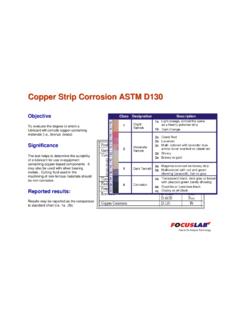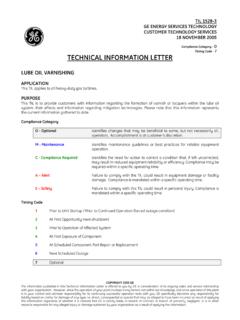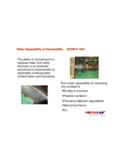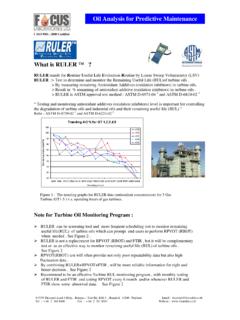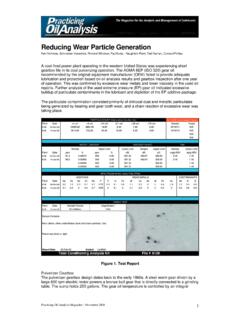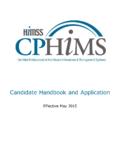Transcription of JFS Residue Analysis on RPVOT test sampes for …
1 Journal of Testing and Evaluation, Sept 2002 Vol XX, No. X. Paper ID: Available online at: Published XXXX. JOURNAL PAPER TYPE. Andy Sitton,1 Jo Ameye2, Robert E. Kauffman3, {Journal Author}. Residue Analysis on RPVOT test samples for single and multiple antioxidants chemistry for turbine lubricants ABSTRACT: Antioxidant chemistry is playing an important role in meeting the longer-life and higher temperature performance criteria of modern generation turbine lubricants. Oxidative life assessment is therefore an important parameter as part of today's turbine oil diagnostic services, where methods such as RPVOT , FTIR and RULER are being applied. With this paper, we will discuss how RPVOT (per ASTM D-2272) testing of turbine lubricants with single antioxidant systems have much better reproducibility and repeatability than comparable RPVOT .
2 Testing of oils with complex, synergistic mixtures of antioxidants. Both new and used turbine oils obtained from gas and steam turbines were used to assess the effects of antioxidant chemistry on the RPVOT results. In the first part of this research program, we present the analytical results for the residues remaining at the completion of the RPVOT tests of single component antioxidant oils. The RULER, varnish potential index (VPI), FTIR, AN and viscosity analyses of the residues are very similar indicating that the residues contain no remaining antioxidants and have elevated levels of VPI, AN, viscosity and FTIR oxidation, , all of the RPVOT residues of the single antioxidant oils are highly oxidized when the test is ended based on oxygen uptake.
3 In the second part, we present the analytical results for the RPVOT residues of complex mixture antioxidant oils. In contrast to the single antioxidant oils, the analytical tests of the complex antioxidant RPVOT residues indicate that the concentration of antioxidant and the level of oxidation varies with antioxidant formulation when the test is ended based on oxygen uptake. The results presented in this paper indicate that the effects of antioxidant chemistry on the Residue content of RPVOT tests help explain the poor reproducibility of the RPVOT tests for turbine oils containing different types of antioxidant systems. Consequently, RULER analyses to characterize the antioxidant systems of the turbine oils before and after RPVOT testing would be very valuable in interpreting the RPVOT results and in improving the reproducibility of the RPVOT technique for making oxidative life assessments of modern generation turbine lubricants.
4 VPI assessments of the turbine oils would further improve the oil diagnostic services of turbine lubricants by providing insight into the capability of the lubricants to solubilize the oxidation products of the antioxidants and the highly-refined base-oil. KEYWORDS: antioxidants, remaining useful life, voltammetry, RPVOT , varnish index potential, oxidation, phenols, aromatic amines, steam turbines, gas turbines Introduction There have been countless instances of problematic turbine engine failures that have yielded used oil samples with a darker than normal appearance and a foul odor, yet conventional used oil testing of these samples has shown quite normal test results. Even on normally operating turbine 1.
5 Focus Laboratories, Bangkok, Thailand;. {Journal footnote text}. 2. Fluitec International, Rutledge, GA, 30663 3. University of Dayton Research Institute, Dayton, Ohio - Copyright 2002 by ASTM International, 100 Barr Harbor Drive, PO Box C700, West Conshohocken, PA 14928-2959. 2. engines, the routine predictive Analysis of the lubricant for Remaining Useful Life has been considered to be less of a science, and closer to an art form, for many decades. The most popular test for measuring oxidation stability, Rotating Pressurized Vessel Oxidation Test ( RPVOT ), has been widely used and touted as an industry standard, while at the same time, the test results are often ignored, especially when the results come into conflict with other test data or other operating criteria.
6 Typical examples of this phenomenon, are when the RPVOT of the new oil, is lower in value than the RPVOT of the in-service oil, or when the in-service oil RPVOT results are far out of range with the new oil data, yet the oil has only been in use for a short period time and no other abnormal parameter can be found with the oil. Some real-life RPVOT data are given in this paper in the section titled RPVOT Reproducibility Issues. It is the authors experience that true, blind, inter-laboratory round-robin testing for RPVOT , can not achieve the Reproducibility values as specified by ASTM D-2272 method. The RPVOT test is designed to be a performance test for measuring the remaining test life of in- service oils.
7 It takes into account the natural anti-oxidative properties of the base-oil as well as the oxidation inhibiting capabilities of the Anti-oxidant additive for the base-oil. The RPVOT . does this by stressing the oil in a pressure vessel with oil, water, copper catalyst, heat and pure oxygen. The test is considered to be complete (formulated and natural antioxidants depleted), when the oxygen pressure drops (base-oil undergoing rapid oxidation) by a specified amount below the maximum pressure developed. Therefore, once the test is completed, the antioxidants should be totally depleted and the base-oil undergoing accelerated oxidation resulting in increased acid number (AN) and Viscosity values with respect to the new oil.
8 Since inter- laboratory testing found poor Reproducibility values for RPVOT , the authors took a closer look at the residual oils from different RPVOT tests and found that the AN and Viscosity values of numerous residual oils were not increased with respect to the new oil. Consequently, it was decided to investigate further into this phenomenon by studying the oils as brand name groups, and to widen the scope of testing of the residual oils, to include FTIR spectroscopy (base-oil oxidation),Voltammetry (antioxidant depletion) and colorimetric stain (Varnish Potential Index). analyses. It was discovered that 6 different types of oils using mono-type Anti-Oxidant additive packages were fully oxidized during the RPVOT test, as measured by the AN, Kinematic Viscosity, FTIR.
9 Spectroscopy, Voltammetry and Varnish Potential Index. These oils are called Sensitive to the RPVOT test. In contrast to the mono-type additive packages, 3 different types of oils using complex (Synergistic) Anti-Oxidant additive packages were found to not fully oxidize during the RPVOT test, as measured by the same criteria. These oils are called non-Sensitive to the RPVOT . test. This paper demonstrates that while the exact Anti-Oxidant chemistry of branded turbine oils remains as trade secrets of the oil refiners, there should be an assessment made, by the oil refiner, of whether or not, their brand of oil is sensitive or non-sensitive to RPVOT testing. This assessment should then be made part of the product Specification sheet.
10 This will help clear up much confusion in the minds of many turbine engine owners and operators. It is also recommended to the ATSM committee, that further study may be required to answer the question; can the RPVOT test method be modified to allow testing of non-Sensitive oils?? 3. 1. The important Role of Antioxidants in Modern Lubricants When modern turbine lubricants are developed, the lubricant manufacturing company has an important role of developing a lubricant which shall correspond to the particular turbine's performance requirements. Basically that means that an important role is dedicated to the development and selection of the base oil in combination with the selection of the additives.
